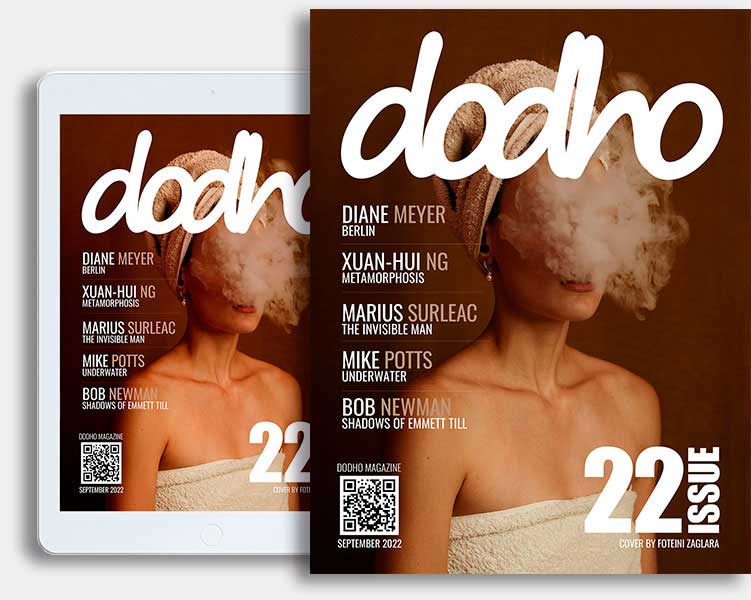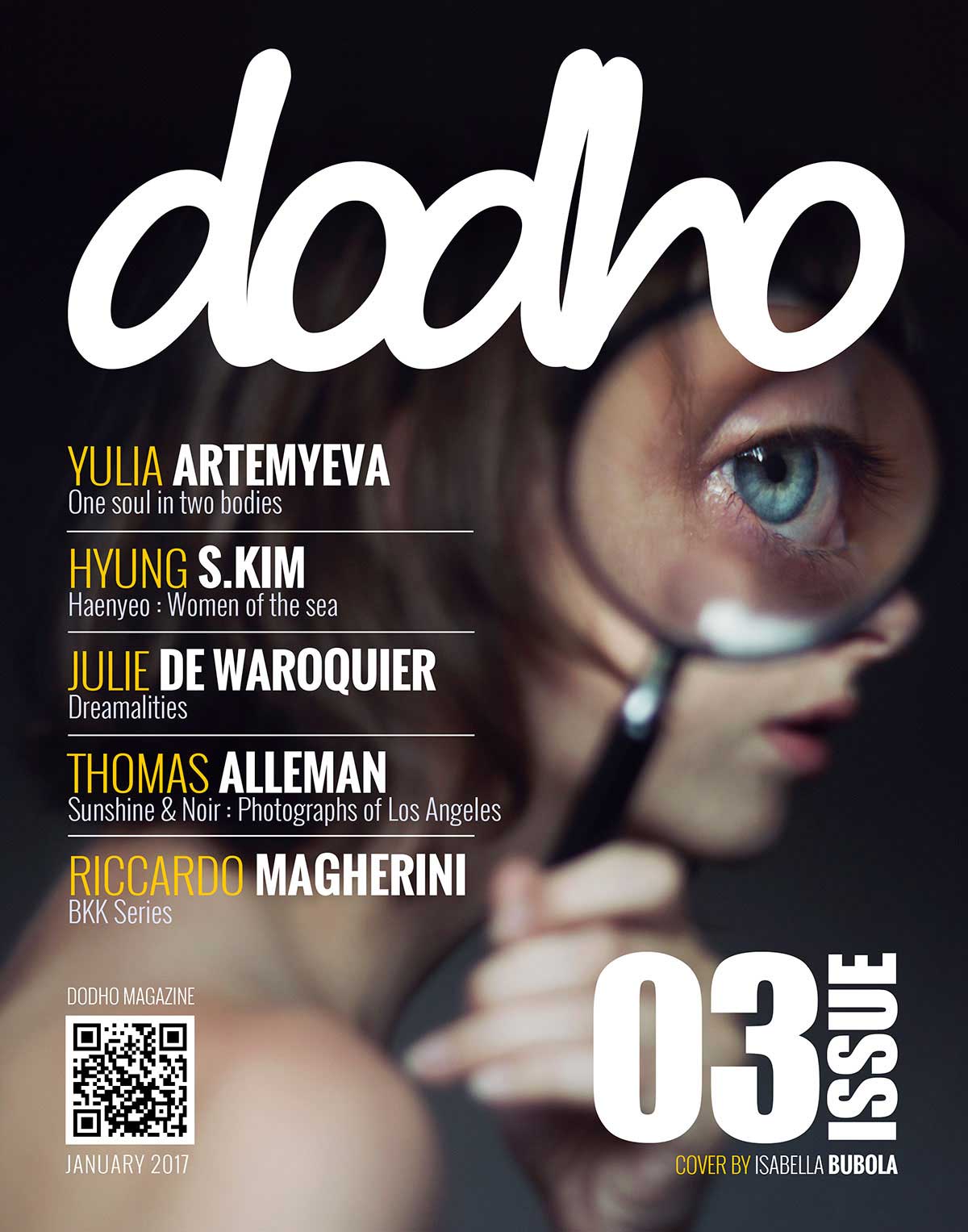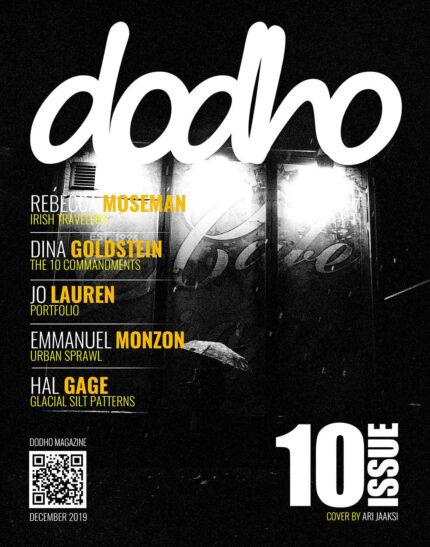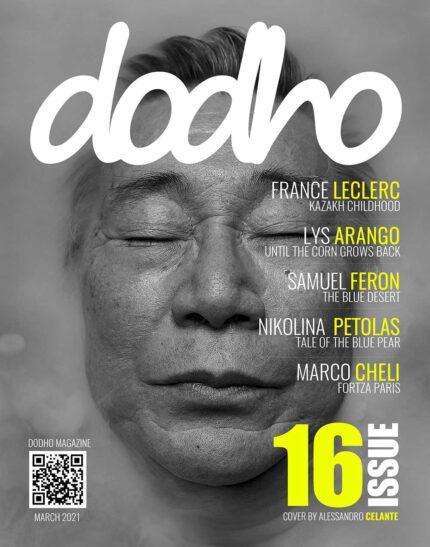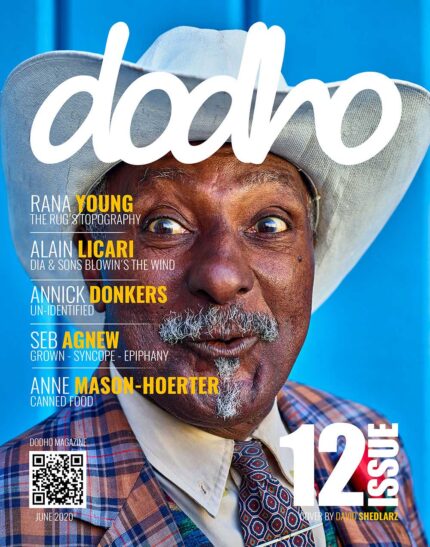Issue #03
Printed on premium 80# matte paper at a perfect size of 22x28cm, our 100-page Dodho Magazine offers an extraordinary tactile experience, immersing you in the world of contemporary photography.
In today’s digital realm, Dodho Magazine has swiftly risen as a leading influencer in contemporary photography. Our mission is clear: unearth and showcase remarkable creations of captivating photographers spanning the globe. This unwavering mission is driven by a passionate commitment to the multifaceted artistry of photography. We invite you to immerse yourself in the vibrant realm of creativity through our complimentary digital edition. Every page acts as a gateway to the core of global contemporary photography. The latest edition proudly displays exceptional endeavors of gifted photographers worldwide. Download your digital copy and join us on this exhilarating visual voyage. If the tangible resonates more, opt for the print version, holding a piece of artistry in your hands.
DOWNLOADPUBLISHED PHOTOGRAPHERS
Isabella Bubola | Cover | She is a 26 year old applied arts graduate and photographer from Croatia. Although she has always been involved in art, it wasn’t until she was about to finish high school that she changed her mind about studying languages and decided to take up art education instead.Her primary focus is on fine art and portrait photography, but she also works in the field of graphic design, jewellery design (brand Coolaž) and illustration. Her works have been exhibited on numerous group exhibitions (among which ‘’Dissociation’’, ‘’Gloria Photo Talent Campus’’, with Peter Lindbergh as one of the jurors; ‘’Rovinj Photodays’’, where she won the award for the diptych Concept) and she participated in a number of international art workshops (Hidden Live(r)s of Venice (Venice, 2011, men- tor Rajko Grlić), Mapping Komiža Narratives (Komiža, 2013), Triangel (Bentlage, 2014) and Fotosofia (Terme Tuhelj, 2015).The meeting point of all visual disciplines she works in was in her final thesis, a magazine about the correla- tion between the media and society with an emphasis on beauty.
Hyung Sun Kim | Haenyeo | Haenyeo are the Korean female divers who harvest seafood by diving into the ocean without diving equipment or breathing apparatus. The Haenyeo culture is Korea’s unique indigenous cultural heritage that has a history that goes back to the primitive age when people began to dive for food in the sea. Most Haenyeo reside in Jeju Island nowadays, located in the southern end of Korean peninsula, and these women, being the primary providers of their families, have formed the familial, cultural, and essential core of the entire island. Haenyeo knows that the sea is a subject to be tendered and preserved, instead of being mass harvested.The knowledge and wisdom they obtained has been passed down to future generations. They accumulated harvesting skills and marine knowledge by adapting to the ocean environment. They are also known as ‘Eco-Feminists’ because they played a major role in supporting the family and formed a powerful female community.The diving practice seems to have begun before the period of the Three Kingdoms of Korea, judging from the fact that Jeju had a record of contributing pearls to the King. Jeju topography written by Lee Gun in 1629 recorded that Haenyeo harvested abalones and further records of Haenyeo exist in the Annals of the Joseon Dynasty and they have also been noted in literature since 1105.
Julie de Waroquier | Dreamalities | She is a self-taught French photographer, also philosophy teacher, who started photography in 2008. Since 2010, she has distinguished herself by winning several national and international awards, including the International Emerging Artist Award. Her photographs are regularly exhibi- ted, and were notably showcased at the Rencontres d’Arles.Julie de Waroquier is represented by several art galleries, and she partici- pates in many French and internatio- nal art fairs and events. Her work has been worldwide published, and in the end of 2012, she has published her first book “Dreamalities”, which is edited by KnowWare editions. In 2014, this book is adapted as a short film, in collabora- tion with the film-maker and director Damien Steck. The film has been awarded in several international festivals. She also regularly works for famous brands or magazines (such as Univer- sal Music, Adobe, Nikon or Nokia). Fi- nally, she is a regular author for French magazines focusing on the art of photography such as Compétence Photo, writing both practical and theoretical articles.Along her main project which is en- titled “Dreamalities”, she works on various series; some of them are narrative, other are rather documentary. All of them have one thing in common though: they tell stories about the human mind and its connection with the material world.
Yulia Artemyeva | One soul in two bodies | She was born in Gorky (Nizhny Novgorod) in 1983. She completed a degree in Economics in 2006. In 2010, she was awarded a qualification in Art Photography by the Academy of International Collaboration in Moscow.In 2015, she received the title of Excellence Artist of FIAP (EFI- AP) from The International Federation of Photographic Art (FIAP, France). In 2016, she was taught by Elena Sukhoveeva (Russia).Her works have been exhibited at group exhibitions throughout Europe, North and South America and Asia.She is a winner and finalist of numerous international photography competitions and awards among which are FIAP exhibitions, IPA 2016, Portraits 2017 (The Center for Fine Art Photography). The presence of an animal in the portrait of a person is one of the most popular ways of depicting and sometimes contrasting with how the viewer percepts it. A classical approach is to depict a commander mounted on horseback in a ceremonial portrait, or a bird as a symbol of soul in children’s ceremonial portraits of the Renaissance. At present, this approach is being developed within the genre of psychological art-portrait.
Riccardo Magherini | BKK Series | Sometimes that sense of estrangement that catches you when you are far away from home, in a new and unknown place, among people who do not speak your language and signs that you do not understand, can be a precious source of creativity and inspiration.Riccardo Magherini, an Italian awarded photographer, plays with that feeling letting himself wandering with.His unique street photography style starts with faces and stories, when one stands out to him.He collects pictures all around that moment, which talk about it. Then shots are composed and merged, ‘shaped’ to tell that story, to suggest the feeling of that moment.Hong Kong, New York, Tokyo, Lisbon: his works, shot in the great metropo- lises of the world, sublime street life, recreating sensations through the time and space overlapping.In his photographs a strong focus point grasp the look from getting lost, allowing us to dive between volumes, shapes and situations. BKK, his last series, bring us through the streets of Bangkok, amongst the crowd, the smoke, the food, the marketplaces.
Thomas Alleman | Sunshine & Noir : Photographs of Los Angeles | I began making “urban landscapes” with a medium-format Holga—a $30 plastic camera—in September of 2001, in the immediate aftermath of the 9/11 terrorist attacks. My heart was shattered then; I was horrified and bewildered by the TV images of those planes, and the newspaper stories that followed, and I was alienated from hope. My magazine career, which depended on the attention of New York photo editors, was momentarily stalled: they had their eyes on Ground Zero and the war of reprisal in Afghanistan, and were indifferent, of course, to the California surfers and CEOs and schoolteachers I’d been photographing for them. In that upside down time, I truly had nothing better to do than walk all day, every day, in Los Angeles’ many strange neighborhoods, searching the blight for pictures that embodied my grief, and, in a nihilistic mood, The Holga’s many laughable failures are well known and all-encompassing: focus, exposure and parallax are effectively uncontrollable, and the plastic lens is always aberrant, cloudy and vignetted. Much to my surprise, however, the freaky results of that technical dysfunction resembled precisely the pictures I’d been dreaming of in those nightmare days.


